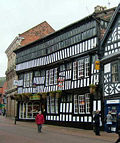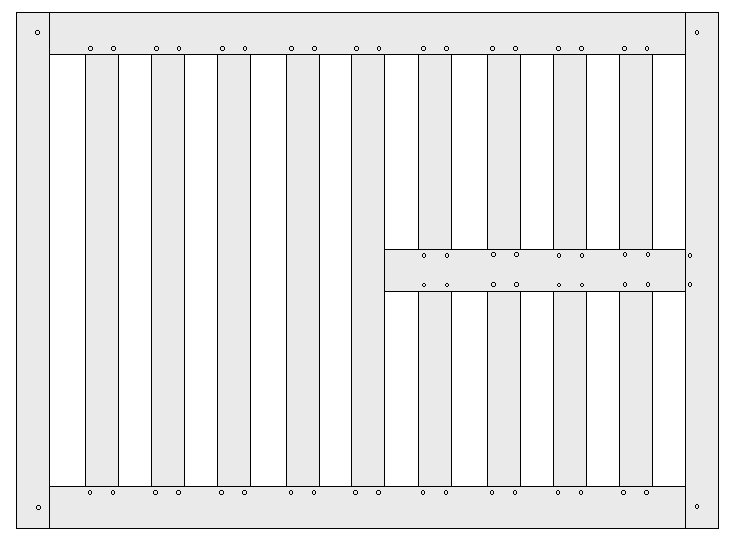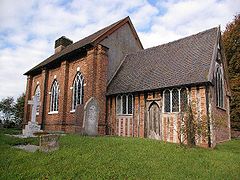
Close studding
Encyclopedia

Timber framing
Timber framing , or half-timbering, also called in North America "post-and-beam" construction, is the method of creating structures using heavy squared off and carefully fitted and joined timbers with joints secured by large wooden pegs . It is commonplace in large barns...
buildings in which vertical timbers (studs) are set close together, dividing the wall into narrow panels. Rather than being a structural feature, the primary aim of close studding is to produce an impressive front.
Close studding first appeared in England in the 13th century and was commonly used there from the mid-15th century until the end of the 17th century. It was also common in France from the 15th century.
Description

Whitewash
Whitewash, or calcimine, kalsomine, calsomine, or lime paint is a very low-cost type of paint made from slaked lime and chalk . Various other additives are also used...
and coloured paints would have been used to enhance the pattern.
History and usage
The use of close studding possibly originated in East AngliaEast Anglia
East Anglia is a traditional name for a region of eastern England, named after an ancient Anglo-Saxon kingdom, the Kingdom of the East Angles. The Angles took their name from their homeland Angeln, in northern Germany. East Anglia initially consisted of Norfolk and Suffolk, but upon the marriage of...
, where the technique was employed in the earliest surviving timber walls thought to date from the early 13th century. Among the earliest examples outside East Anglia are St Michael's Church, Baddiley
St Michael's Church, Baddiley
St Michael's Church, Baddiley is in the civil parish of Baddiley, Cheshire, England. It has been designated by English Heritage as a Grade I listed building. The church lies at the end of a lane near to Baddiley Hall, formerly the home of the Mainwaring family. It dates from the early...
in Cheshire
Cheshire
Cheshire is a ceremonial county in North West England. Cheshire's county town is the city of Chester, although its largest town is Warrington. Other major towns include Widnes, Congleton, Crewe, Ellesmere Port, Runcorn, Macclesfield, Winsford, Northwich, and Wilmslow...
(1308) and Mancetter Manor in Warwickshire
Warwickshire
Warwickshire is a landlocked non-metropolitan county in the West Midlands region of England. The county town is Warwick, although the largest town is Nuneaton. The county is famous for being the birthplace of William Shakespeare...
(c. 1330). It became fashionable in England around 1400, and by the middle of the 15th century close studding was widely used across that country. Its popularity coincided with the dominance of the Perpendicular style of architecture, with its emphasis on verticals. Close studding remained in common use in England until the end of the 17th century. Close-studded buildings dating from the 15th and 16th centuries are also seen in France, and some experts believe the technique might have originated there.

Barnsley
Barnsley is a town in South Yorkshire, England. It lies on the River Dearne, north of the city of Sheffield, south of Leeds and west of Doncaster. Barnsley is surrounded by several smaller settlements which together form the Metropolitan Borough of Barnsley, of which Barnsley is the largest and...
. Although most examples occur in entirely timber-framed buildings, close studding was also used on the upper storeys of houses with a stone or brick ground storey; examples include the Dragon Hall in Norwich
Norwich
Norwich is a city in England. It is the regional administrative centre and county town of Norfolk. During the 11th century, Norwich was the largest city in England after London, and one of the most important places in the kingdom...
and the Café 'Cave St-Vincent' in Compiègne
Compiègne
Compiègne is a city in northern France. It is designated municipally as a commune within the département of Oise.The city is located along the Oise River...
, France.
With its lavish use of timber, close studding was extravagant and was seen as a status symbol. This led to it being faked with paint or even cosmetic planking. The heavy timber consumption probably also contributed to the decline in the use of close studding from the end of the 17th century, with a reduced supply of domestic hardwood as well as increased competition for timber.
Variations

Lavenham
Lavenham is a village and civil parish in Suffolk, England. It is noted for its 15th century church, half-timbered medieval cottages and circular walk. In the medieval period it was among the 20 wealthiest settlements in England...
and the Chantry House in Bunbury
Bunbury, Cheshire
Bunbury is a village and civil parish in the unitary authority of Cheshire East and the ceremonial county of Cheshire, England, south of Tarporley, north west of Nantwich, and on the Shropshire Union Canal...
. In later use, however, braces were usually constructed on the interior and concealed by plaster panelling.
Close studding was sometimes used in association with decorative panel work or close panelling, particularly from the end of the 16th century. In such buildings, the lower storey would usually employ close studding, while the upper storeys would have small square panels with or without ornamentation. Examples include the White Lion in Congleton
Congleton
Congleton is a town and civil parish in the unitary authority of Cheshire East and the ceremonial county of Cheshire, England, on the banks of the River Dane, to the west of the Macclesfield Canal and 21 miles south of Manchester. It has a population of 25,750.-History:The first settlements in...
and Moat Farm in Longdon
Longdon, Worcestershire
Longdon is a village, and a civil parish in the Malvern Hills District in the county of Worcestershire, England....
. An ornamental effect was also sometimes obtained with herringbone or chevron bracing between the uprights.
Churches
- Church of St James and St Paul, Marton, CheshireMarton, CheshireMarton, Cheshire is a small village and civil parish in the unitary authority of Cheshire East and the ceremonial county of Cheshire, England on the A34 road 3 miles north of Congleton ....
: close studding with middle rail (c. 1370) - St Michael's ChurchSt Michael's Church, BaddileySt Michael's Church, Baddiley is in the civil parish of Baddiley, Cheshire, England. It has been designated by English Heritage as a Grade I listed building. The church lies at the end of a lane near to Baddiley Hall, formerly the home of the Mainwaring family. It dates from the early...
, BaddileyBaddileyBaddiley is a scattered settlement and civil parish in the unitary authority of Cheshire East and the ceremonial county of Cheshire, England. The civil parish also includes the north-western part of the village of Ravensmoor , as well as the small settlements of Baddiley Hulse, Batterley Hill, and...
, Cheshire: the chancel has close studding without a middle rail, with later brick infill (1308) - St Michael and All Angels ChurchSt Michael and All Angels Church, AltcarSt Michael and All Angels Church, Altcar, is to the west of the village of Great Altcar, West Lancashire, England. The church is timber-framed and has been designated by English Heritage as a Grade II* listed building. It is an active Anglican parish church in the diocese of Liverpool, the...
, AltcarGreat AltcarGreat Altcar is a village and civil parish in West Lancashire, close to Formby on the West Lancashire Coastal Plain. The name Altcar is Norse meaning "marsh by the Alt". The church of St Michael and All Angels is a timber framed structure dating from 1879....
, West LancashireWest LancashireWest Lancashire is a non-metropolitan district with the status of a borough in Lancashire, England. Its council is based in Ormskirk. The other town in the borough is Skelmersdale....
: mostly close studded with middle rail (a much later example of 1879) - St Peter's Church, MelverleyMelverleyMelverley is a village in Shropshire, England, situated on the River Severn and the River Vyrnwy, near the Powys hills and the border with Wales...
, ShropshireShropshireShropshire is a county in the West Midlands region of England. For Eurostat purposes, the county is a NUTS 3 region and is one of four counties or unitary districts that comprise the "Shropshire and Staffordshire" NUTS 2 region. It borders Wales to the west...
: close studding with middle rail (late 15th century)
Inns and cafés
- Bear's Head Hotel, BreretonBrereton, CheshireBrereton is a civil parish, containing the hamlet of Brereton Green in the unitary authority of Cheshire East and the ceremonial county of Cheshire, England. It also contains the hamlets of Brereton Heath and Smethwick Green. According to the 2001 census, the population of the entire civil parish...
, Cheshire: close studding with two rails (1615) - Café 'Cave St-Vincent', CompiègneCompiègneCompiègne is a city in northern France. It is designated municipally as a commune within the département of Oise.The city is located along the Oise River...
, France: close studding with braces on upper storey over brick ground floor with stone trimming (15th century) - Crown HotelCrown Hotel, NantwichThe Crown Hotel, also known as the Crown Inn, is a timber-framed, black-and-white hotel and public house located at 24–26 High Street in the town of Nantwich in Cheshire, England. The present building dates from shortly after 1583...
, NantwichNantwichNantwich is a market town and civil parish in the Borough of Cheshire East and the ceremonial county of Cheshire, England. The town gives its name to the parliamentary constituency of Crewe and Nantwich...
, Cheshire: close studding on all three storeys with middle rail (c. 1584) - String of Horses Inn, originally at FrankwellFrankwellFrankwell is a district of the town of Shrewsbury, in Shropshire, England. It lies adjacent to the River Severn, to the northwest of the town centre, and is one of Shrewsbury's oldest suburbs....
, ShrewsburyShrewsburyShrewsbury is the county town of Shropshire, in the West Midlands region of England. Lying on the River Severn, it is a civil parish home to some 70,000 inhabitants, and is the primary settlement and headquarters of Shropshire Council...
, Shropshire, now at Avoncroft Museum of Historic BuildingsAvoncroft Museum of Historic BuildingsAvoncroft Museum of Historic Buildings is an open-air museum of rescued buildings which have been relocated to its site in Stoke Heath, a district of Bromsgrove, Worcestershire, England. Founded in 1963 and opened in 1967, the museum was conceived following the dismantling of a 15th-century...
: close studding with middle rail on both ground and first storeys (1576) - White Lion, CongletonCongletonCongleton is a town and civil parish in the unitary authority of Cheshire East and the ceremonial county of Cheshire, England, on the banks of the River Dane, to the west of the Macclesfield Canal and 21 miles south of Manchester. It has a population of 25,750.-History:The first settlements in...
, Cheshire: lower storey has close studding, with decorative panelling above (early 16th century) - The FalconThe Falcon, ChesterThe Falcon is a public house in Chester, Cheshire, England. It stands on the west side of Lower Bridge Street at its junction with Grosvenor Road. The Falcon has been designated by English Heritage as a Grade I listed building...
, ChesterChesterChester is a city in Cheshire, England. Lying on the River Dee, close to the border with Wales, it is home to 77,040 inhabitants, and is the largest and most populous settlement of the wider unitary authority area of Cheshire West and Chester, which had a population of 328,100 according to the...
, Cheshire, formerly a town house, now a public house, which has close studding on its east front at the level of the Chester RowsChester RowsChester Rows consist of covered walkways at the first floor behind which are entrances to shops and other premises. At street level is another set of shops and other premises, many of which are entered by going down a few steps...
.
Private houses
- Chantry House, Bunbury, CheshireBunbury, CheshireBunbury is a village and civil parish in the unitary authority of Cheshire East and the ceremonial county of Cheshire, England, south of Tarporley, north west of Nantwich, and on the Shropshire Union Canal...
: very close studding, with tension braces and arch bracing and no middle rail. (1527) - Gawsworth Old RectoryGawsworth Old RectoryGawsworth Old Rectory is a house in the village of Gawsworth, Cheshire, England. It has been designated by English Heritage as a Grade I listed building...
, GawsworthGawsworthGawsworth is a civil parish and village in the unitary authority of Cheshire East and the ceremonial county of Cheshire, England. It is one of the eight ancient parishes of Macclesfield Hundred. Twenty acres of the civil parish were transferred to Macclesfield civil parish in 1936The country houses...
, Cheshire: close studding with middle rail and arch bracing (late 16th century) - Greyfriars, WorcesterWorcesterThe City of Worcester, commonly known as Worcester, , is a city and county town of Worcestershire in the West Midlands of England. Worcester is situated some southwest of Birmingham and north of Gloucester, and has an approximate population of 94,000 people. The River Severn runs through the...
, WorcestershireWorcestershireWorcestershire is a non-metropolitan county, established in antiquity, located in the West Midlands region of England. For Eurostat purposes it is a NUTS 3 region and is one of three counties that comprise the "Herefordshire, Worcestershire and Warwickshire" NUTS 2 region...
: close studding with middle rail to both storeys (c.1480–1500) - Mancetter Manor, MancetterMancetterMancetter is a village and civil parish on the outskirts of Atherstone in North Warwickshire, at the crossing of Watling Street over the River Anker.-History:...
, WarwickshireWarwickshireWarwickshire is a landlocked non-metropolitan county in the West Midlands region of England. The county town is Warwick, although the largest town is Nuneaton. The county is famous for being the birthplace of William Shakespeare...
: close studding with plaster infill (c. 1330) - Moat Farm, LongdonLongdon, WorcestershireLongdon is a village, and a civil parish in the Malvern Hills District in the county of Worcestershire, England....
, Worcestershire: close studding with middle rail on ground floor; upper floor mixes square framing and decorative panelling - Moss HallMoss Hall, AudlemMoss Hall, Audlem, is a manor house to the northwest of Audlem, Cheshire, England. It has been designated by English Heritage as a Grade I listed building. Moss Hall is situated to the west of Audlem, overlooking the Shropshire Union Canal....
, AudlemAudlemAudlem is a large village and civil parish located in the unitary authority of Cheshire East and the ceremonial county of Cheshire in the north west of England, approximately south of Nantwich. Close to the border with the neighbouring county of Shropshire, the village is eight miles east of...
, Cheshire: close studding with middle rails to each storey, with no decorative panelling (1616) - Paycocke's, CoggeshallCoggeshallCoggeshall is a small market town of 3,919 residents in Essex, England, situated between Colchester and Braintree on the Roman road of Stane Street , and intersected by the River Blackwater. It is known for its almost 300 listed buildings and formerly extensive antique trade...
, EssexEssexEssex is a ceremonial and non-metropolitan county in the East region of England, and one of the home counties. It is located to the northeast of Greater London. It borders with Cambridgeshire and Suffolk to the north, Hertfordshire to the west, Kent to the South and London to the south west...
: the main elevation has close studding on both storeys, with a middle rail on the ground floor (c. 1500)
Public halls
- Booth Hall or Round House, EveshamEveshamEvesham is a market town and a civil parish in the Local Authority District of Wychavon in the county of Worcestershire, England with a population of 22,000. It is located roughly equidistant between Worcester, Cheltenham and Stratford-upon-Avon...
, Worcestershire: close studding with middle rail on all three storeys (late 15th century) - Dragon Hall, NorwichNorwichNorwich is a city in England. It is the regional administrative centre and county town of Norfolk. During the 11th century, Norwich was the largest city in England after London, and one of the most important places in the kingdom...
, NorfolkNorfolkNorfolk is a low-lying county in the East of England. It has borders with Lincolnshire to the west, Cambridgeshire to the west and southwest and Suffolk to the south. Its northern and eastern boundaries are the North Sea coast and to the north-west the county is bordered by The Wash. The county...
: close studding without middle rail to first floor, over brick and flint ground floor (14th century) - Guildhall, LavenhamLavenhamLavenham is a village and civil parish in Suffolk, England. It is noted for its 15th century church, half-timbered medieval cottages and circular walk. In the medieval period it was among the 20 wealthiest settlements in England...
, SuffolkSuffolkSuffolk is a non-metropolitan county of historic origin in East Anglia, England. It has borders with Norfolk to the north, Cambridgeshire to the west and Essex to the south. The North Sea lies to the east...
: close studding to all storeys, with tension braces and no middle rail (early 16th century) - Moot Hall, FordwichFordwichFordwich is the smallest place in Britain with a town council, having a population of 351 recorded in the 2001 census. It lies in Kent, on the River Stour, northeast of Canterbury....
, KentKentKent is a county in southeast England, and is one of the home counties. It borders East Sussex, Surrey and Greater London and has a defined boundary with Essex in the middle of the Thames Estuary. The ceremonial county boundaries of Kent include the shire county of Kent and the unitary borough of...
: close-studded overhanging first storey with brick or plaster infill and no middle rail; the ground floor in brick and flint was rebuilt at a later date (early 15th century) - Town residence, Albi, France: close studding on three storeys (16th century)
Sources
- Harris R. Discovering Timber-framed Buildings (Shire Publications, Princes Risborough; 2003) (ISBN 0-7478-0215-7)
- McKenna L. Timber Framed Buildings in Cheshire (Cheshire County Council; 1994) (ISBN 0906765161)
- Brooks A, Pevsner N. Worcestershire: The Buildings of England (revised edn) (Yale University Press; 2007) (ISBN 030011298X)

